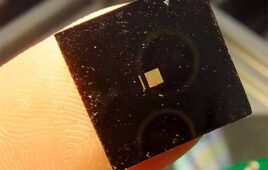
A schematic drawing of ultrasound-induced cell activation and gene expression. [Image from UCSD]
The ultrasound-based system is able to non-invasively and remotely control the genetic process in immune T cells to identify and kill cancer cells. According to the researchers, the ability to non-invasively and remotely manipulate cells at a distance is important for translational application in humans.
University of California San Diego researchers developed the system using a new approach to mechanogenetics, which is a field of science that involves showing how physical focus and changes in mechanical properties in cells and tissue can affect gene expression. The new approach acted as a remote control of gene and cell activators and the researchers could use ultrasound to mechanically disturb T cells and convert the mechanical signals into a genetic control of the cells.
The study shows how the remote-controlled mechanogenetics system could engineer chimeric antigen receptor (CAR)-expressing T cells to identify and kill cancer cells. Engineered CAR-T cells have mechano-sensors and can be remotely activated by ultrasound using a microbubble amplification.
“CAR-T cell therapy is becoming a paradigm-shifting therapeutic approach for cancer treatment,” bioengineering professor at UCSD Peter Yingxiao Wang said. “However, major challenges remain before CAR-based immunotherapy can become widely adopted. For instance, the non-specific targeting of CAR-T cells against nonmalignant tissues can be life-threatening. This work could ultimately lead to an unprecedented precision and efficiency in CAR-T cell immunotherapy against solid tumors, while minimizing off-tumor toxicities.”
Researchers on the study discovered that microbubbles conjugated to streptavidin is able to be coupled on the surface of a cell. The surface of a cell is where mechxnosensitive Piezo1 ion channels are expressed. Microbubbles then vibrate when exposed to ultrasound waves and the Piezo1 ion cancels are mechanically stimulated to allow calcium ions inside the cell. As a result, calcineurin activation, NFAT dephoshorylation and translocation into the nucleus occur. Nucleus-translocated NFAT binds to upstream response elements of genetic transfusing modules to trigger gene expression of CAR to kill targeted cancer cells, according to the researchers.
The research was published in the Proceedings of the National Academy of Sciences journal was was supported by the National Institutes of Health, the National Science Foundation and the Beckman Laser Institute Foundation.




